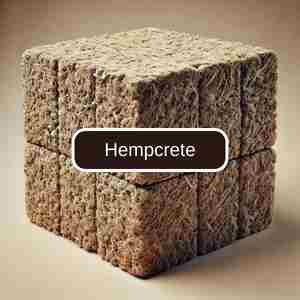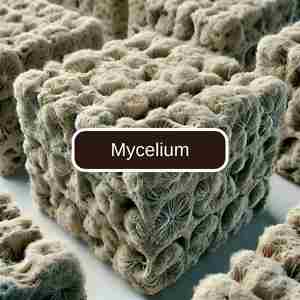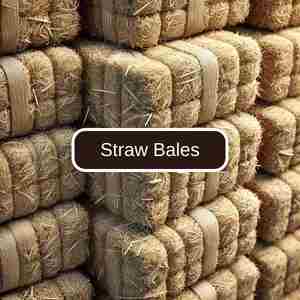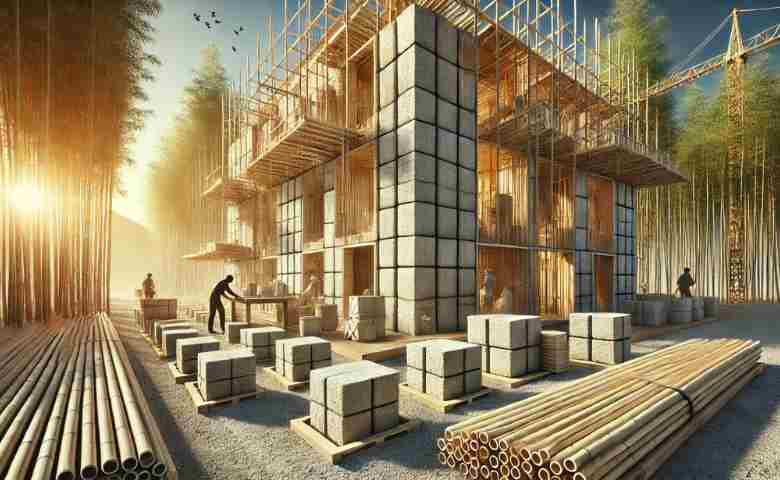Last Updated on November 13, 2024 by Admin
The construction industry is witnessing a pivotal shift as sustainability becomes essential. Bio-based construction materials have gained traction, embodying the values of eco-friendly, sustainable building practices. Unlike traditional materials that rely on non-renewable resources and cause environmental degradation, bio-based materials offer renewable, biodegradable options with a lower carbon footprint.
This article explores the rise of bio-based materials like hempcrete, bamboo, and mycelium and highlights their advantages in modern construction. With a growing emphasis on sustainable practices, understanding these materials is critical for professionals in construction, architecture, and real estate.
Table of Contents
What Are Bio-Based Construction Materials?
Bio-based construction materials are derived from organic, renewable sources such as plants, fungi, or agricultural waste. Unlike synthetic materials, these materials are biodegradable and sustainable, making them an attractive choice for reducing long-term environmental impact. Common examples include hempcrete, bamboo, straw, mycelium, and recycled wood, each offering distinct benefits and applications.
Practice 15+ AI-generated technical and HR interview questions for Civil, BIM, QS, Planning, HSE and Construction roles. Get instant feedback, improved answers, a 7-day improvement plan, and a full PDF report. Designed exclusively for construction professionals.
One free full interview session included. No credit card required.
Key Bio-Based Materials Gaining Popularity
- Hempcrete: Comprising hemp fibers, lime, and water, hempcrete is a lightweight, insulating material that provides thermal efficiency and durability. Learn more about hempcrete and its benefits in construction.
- Bamboo: Known for its rapid growth, bamboo is a highly sustainable construction material, particularly suitable in regions prone to earthquakes due to its flexibility.
- Mycelium: This innovative, fungal-based material shows promise in insulation and structural applications, with the added benefit of being fully biodegradable.
- Straw Bales: Straw bales serve as insulation in building walls, providing effective thermal performance and fire resistance.
Environmental Benefits of Bio-Based Materials
The ecological advantages of bio-based materials are central to their appeal in sustainable construction. By using renewable resources, bio-based materials reduce dependency on non-renewable options such as concrete, steel, and plastic, all of which require energy-intensive production and result in significant carbon emissions.
Reduced Carbon Footprint
Bio-based materials like hempcrete and bamboo have a carbon-negative footprint, meaning they capture more CO₂ during their growth than they emit during production. In contrast, traditional materials such as cement generate approximately one ton of CO₂ per ton produced. Conversely, hempcrete can sequester up to 0.6 tons of CO₂ per ton produced, making it a highly sustainable alternative.
For further insight into the carbon footprint of construction materials, explore Sustainable Building Practices.
Energy Efficiency
Natural insulation properties in bio-based materials can significantly enhance a building’s energy efficiency. Hempcrete, for example, provides excellent thermal insulation, which reduces the need for extensive heating or cooling systems, resulting in lower energy consumption. This feature is precious in extreme climates where energy conservation is critical.
How Do Bio-Based Materials Compare to Traditional Options?
Bio-based materials have environmental benefits, but their performance and adaptability in construction must also meet industry standards to be practical.
Durability and Longevity
- Bio-Based Materials: When used correctly, materials like bamboo and hempcrete are highly durable. Bamboo offers tensile strength comparable to steel, making it a viable structural option.
- Traditional Materials: While materials like steel and concrete are known for their longevity, bio-based materials are becoming increasingly competitive in terms of durability due to innovations enhancing their structural properties.
For more on material durability, visit the Building Materials section.
Cost Considerations
A primary challenge for bio-based materials is cost. Due to limited production infrastructure, many of these materials are still more expensive than traditional options. However, costs are expected to decrease as demand increases and production scales. Additionally, energy savings and reduced maintenance costs can offset the initial investment in bio-based materials.
Adaptability and Versatility
Bio-based materials enable unique and aesthetically pleasing design possibilities. However, traditional materials currently enjoy wider applications and standardized building codes, offering some advantages. Despite this, materials like bamboo and hempcrete are recognized for their versatility and ability to support sustainable building practices.
Prominent Bio-Based Materials in Modern Construction
Below are some key materials driving the adoption of bio-based options in sustainable construction:
Hempcrete: The Game-Changer in Wall Insulation

Hempcrete, created from the inner fibers of hemp plants, offers an eco-friendly alternative to concrete for wall insulation. Its properties include excellent thermal insulation, soundproofing, and fire resistance, all while sequestering carbon dioxide. Unlike concrete, hempcrete is lightweight and doesn’t require expansion joints, making it easier to work with.
Bamboo: The “Green Steel” of Construction

Bamboo’s rapid growth, low maintenance, and high strength-to-weight ratio have earned it the nickname “green steel.” Traditionally used in Asia, bamboo has proven to be an excellent material for earthquake-resistant structures due to its flexibility. Globally, bamboo is gaining acceptance as a low-impact alternative to traditional building materials.
Mycelium: A New Frontier in Fungal-Based Insulation

Mycelium, derived from fungi roots, is gaining traction as an innovative insulation material. This fungal-based composite can be grown in molds to create building components, providing a biodegradable alternative to synthetic foams. The natural resistance to fire and pests enhances its appeal in sustainable construction applications.
Straw Bales: Traditional Yet Effective Insulation

Straw bales, an age-old construction material, have re-emerged in sustainable building due to their insulating properties. When used in walls, straw bales provide effective thermal and sound insulation, making them ideal for energy-efficient buildings. They are particularly cost-effective and easily sourced in agricultural regions.
Real-World Examples: Bio-Based Materials in Action
Case Study 1: The Icehouse Project, Netherlands
The Icehouse Project in the Netherlands is a zero-energy residence constructed primarily with bio-based materials, including hempcrete and timber. This project highlights hempcrete’s insulation properties, which reduce energy costs and contribute to a carbon-neutral construction approach. The Icehouse Project serves as a model for eco-friendly homebuilding practices.
Case Study 2: The Green School, Bali, Indonesia
Bali’s Green School, built entirely from locally sourced bamboo, showcases bamboo’s structural strength and aesthetic appeal. This project has set a global precedent for sustainable architecture, inspiring similar approaches in green construction worldwide.
Case Study 3: Mycelium Pavilion, New York, USA
The Mycelium Pavilion in New York is a temporary structure designed to demonstrate mycelium’s potential as a construction material. Grown into blocks and used as building components, mycelium showcases how bio-based materials can be applied innovatively, with minimal environmental impact.
Overcoming Challenges in Bio-Based Material Adoption
While bio-based materials offer significant benefits, their widespread adoption faces a few hurdles:
- Building Codes and Regulations: Building codes are predominantly designed around traditional materials, complicating the approval process for bio-based alternatives.
- Limited Production and Availability: The bio-based material industry lacks extensive infrastructure, leading to limited availability and higher costs.
- Perceived Durability Concerns: Although bio-based materials like bamboo and hempcrete are durable, some stakeholders remain skeptical of their longevity compared to traditional materials.
Support from governments and industry bodies is crucial to overcoming these obstacles. Incentives for sustainable practices and updated building codes will facilitate greater adoption of bio-based materials.
The Future of Bio-Based Construction Materials
As the demand for sustainable construction materials grows, bio-based options are becoming more viable in the industry. Continued research and innovation in bio-based materials are helping them meet durability standards, making them competitive with traditional materials.
Emerging Innovations in Bio-Based Materials
- 3D Printing with Bio-Based Materials: The potential for 3D printing with bio-based materials is vast, enabling complex designs and minimizing waste. This technology could significantly impact construction with bio-based materials.
- Hybrid Materials: Blending bio-based materials with conventional options may enhance durability while maintaining environmental benefits.
- Smart Bio-Based Materials: New materials that respond to environmental changes, such as temperature-sensitive insulation, could further boost building energy efficiency.
For more on innovations in construction technology, visit the Digital Construction Technology section on ConstructionPlacements.
Conclusion
Adopting bio-based building materials represents a positive shift toward sustainable construction practices. While challenges exist, the environmental benefits of materials like hempcrete, bamboo, and mycelium are undeniable. By reducing carbon emissions, enhancing energy efficiency, and fostering a sustainable construction industry, bio-based materials offer promising solutions for the future.
For further reading on sustainable building, explore the Sustainable Construction Services.
This article underscores the transformative potential of bio-based materials in construction, showcasing their ability to help the industry transition toward more sustainable practices. Through continued innovation and regulatory support, bio-based materials can become essential in creating eco-friendly, resource-efficient buildings for future generations.
Related Posts:
- Top 10 Sustainable Construction Materials to Look for In 2024
- Various types of Eco-friendly Materials in Construction?
- The Ultimate Guide to Civil Engineering Materials: What Every Engineer Should Know
- What Type of Insulation Is Best for My Home?
- Insulation Techniques for Homes: Effective Methods for Residential Buildings
- How Does Green Construction Add Value to Homes?


